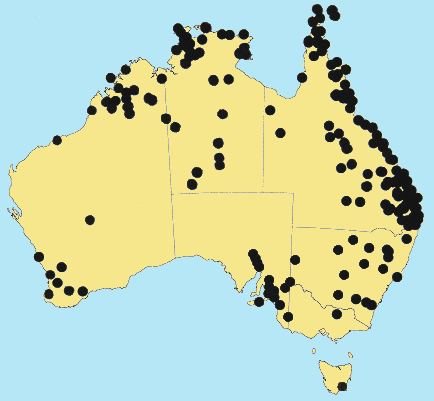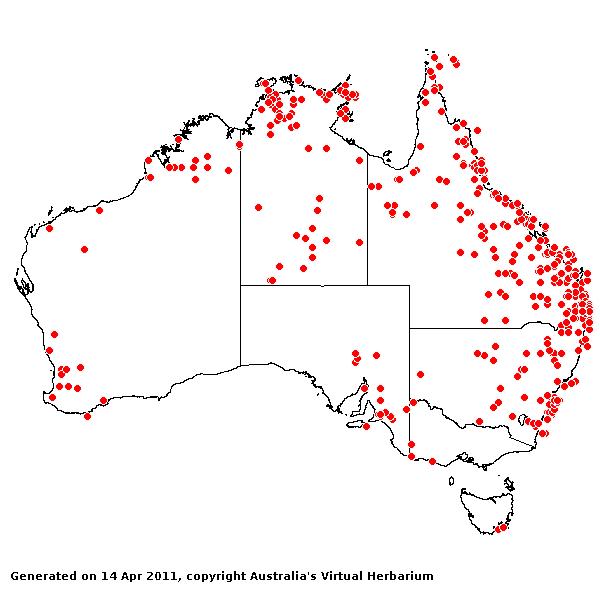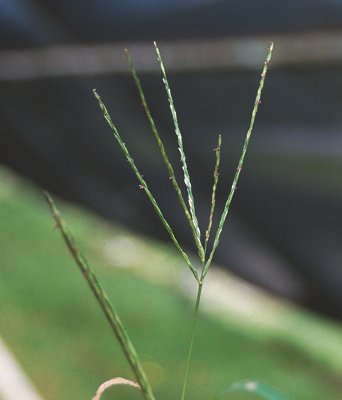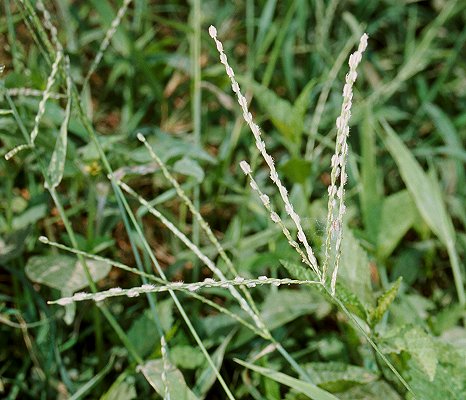Digitaria ciliaris* (Retz.) Koeler. Descr. Gram. 27 (1802).
Classification. (GPWG 2001) : Subfamily Panicoideae. Paniceae.
Basionym and/or Replacement Name: Panicum ciliare Retz., Observ. Bot. 4: 16 (1786).
Type of Basionym or Protologue Information: China: Guangdong: Guangzhou, Wennerberg s.n. (LT: LD).
Recent synonyms: D. adscendens.
Key references (books and floras): [1810]. R.Brown, Prodromus (192 as Panicum ciliare), [1952] C.A.Gardner, Flora of Western Australia 1 Gramineae (227 as D. adscendens), [1969] E.E.Henty, Manual Grasses New Guinea (76 as D. adscendens), [1981] M.Lazarides in J.Jessop (ed)., Flora of Central Australia (474), [2002] D.Sharp & B.K.Simon, AusGrass, Grasses of Australia, [2002] J.Wheeler, N.Marchant & M.Lewington, Flora of the South West (412), [2006] J.Jessop, G.R.M.Dashorst, F.M.James, Grasses of South Australia (440), [2008] S.W.L.Jacobs, R.D.B.Walley & D.J.B.Wheeler, Grasses of New South Wales (215).
Illustrations: [2006] J.Jessop, G.R.M.Dashorst, F.M.James, Grasses of South Australia (440, Fig. 370), [2008] S.W.L.Jacobs, R.D.B.Whalley & D.J.B.Wheeler, Grasses of New South Wales, 4th edn (215).
Habit. Annual. Rhizomes absent. Stolons absent. Culms decumbent, 10–100 cm tall, 2–5 -noded. Mid-culm internodes glabrous. Mid-culm nodes glabrous. Lateral branches sparsely branched. Leaf-sheath auricles present. Ligule an eciliate membrane. Leaf-blades flat, 2–25 cm long, 3–10 mm wide. Leaf-blade surface scabrous, glabrous or indumented.
Inflorescence. Inflorescence subdigitate, with racemose branches. Racemes 2–12, 6–22 cm long. Central inflorescence axis (0–)1.4–2(–9.3) cm long.
Spikelets. Spikelets pedicelled, 2 in the cluster. Fertile spikelets 2-flowered, the lower floret barren (rarely male), the upper fertile, comprising 1 basal sterile florets, comprising 1 fertile floret(s), without rachilla extension, elliptic, dorsally compressed, (2–)2.5–3.3(–3.7) mm long. Rhachilla internodes brief up to lowest fertile floret.
Glumes. Glumes dissimilar, thinner than fertile lemma. Lower glume ovate. Upper glume lanceolate, 1.2–2.7 mm long, membranous, 3 -nerved. Upper glume surface indumented. Florets. Basal sterile florets 1, barren, without significant palea. Lemma of lower sterile floret 100 % of length of spikelet, membranous, 7 -nerved.
Fertile lemma 2–3.8 mm long, without keel, 3 -nerved. Lemma apex muticous. Lodicules absent or vestigial. Anthers 3.
Continental Distribution: Europe, Africa, Temperate Asia, Tropical Asia, Australasia, Pacific, North America, and South America.
Australian Distribution: Western Australia, Northern Territory, South Australia, Queensland, New South Wales, Victoria, Tasmania, Norfolk I, Lord Howe.
Western Australia: Gardner. Northern Territory: Darwin & Gulf. South Australia: Gairdner-Torrens Basin, Eyre Peninsula, Northern Lofty, Murray, Southern Lofty, Kangaroo Island, South-eastern. Queensland: Burke, Burnett, Cook, Darling Downs, Gregory North, Leichhardt, Maranoa, Mitchell, Moreton, North Kennedy, Port Curtis, South Kennedy, Warrego, Wide Bay. New South Wales: North Coast, Central Coast, South Coast, Northern Tablelands, Central Tablelands, North-Western Slopes, Central-Western Slopes, North-Western Plains, South-Western Plains. Victoria: Riverina. Tasmania: East Coast.
Notes. Digitaria ciliaris (2n = 54) is closely related to the tropical D. bicornis (2n = 72) and the temperate D. sanguinalis (2n = 36).
Kimberley to Tasmania (the aggressive weed has the potential of occurring in any of Australia). In temperate heaths, tropical and subtropical wet sclerophyll forests, dry sclerophyll forests, Brigalow forests, tropical and subtropical sub-humid woodlands, temperate sub-humid woodlands, semi-arid shrub woodlands, shrub steppe shrublands, acacia shrublands, arid tussock grasslands, and temperate sub-humid grasslands. An aggressive invader of disturbed soil sites, with the potential of occurring in all vegetation types. Flowers sporadically throughout the year.





